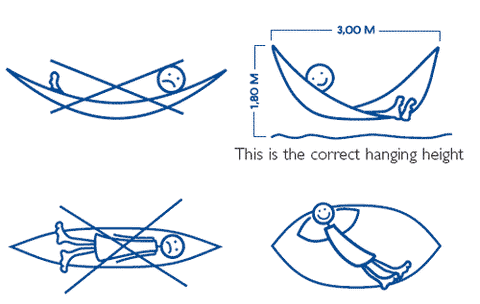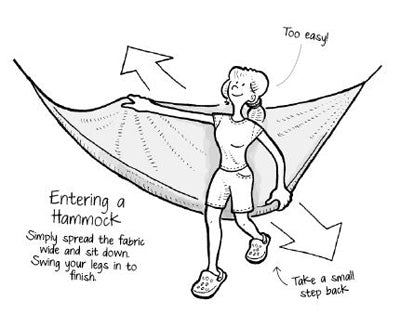You just bought a hammock.
Now what?
We'll briefly go over how to hang your hammock, how to lay in it, how to keep warm, how to keep dry, and how to keep the bugs out. This is a quick guide with pictures and videos.
Hanging a Hammock
Using Rope
Tie one end of a rope to your hammock, and the other end to a tree. You’ll need two sections of rope. You can hang your hammock with just these two knots.
1. Make a loop on one end of the rope, and then clip your carabiner in. We use a simple overhand loop.
2. Tie the other end to a tree with a quick release knot. We use a Siberian hitch. It looks complicated, but it’s actually really easy to tie. You can even do it with mittens on.
A word of warning: Ropes can cut through tree bark and damage the tree. Only use ropes on trees with tough bark that can withstand the pressure. Otherwise, use tree straps.
Using Straps
On softer bark, use tree straps, which spread the pressure over a wider band to protect the bark. Besides being more environmentally friendly, they're easier to use because you won't need to tie any knots.
Laying in It
To get into the hammock, spread it wide to give yourself plenty of room. Sit down as if you were sitting on a sofa, then raise your legs.
Most people naturally lay centered in the hammock, their bodies curved like a banana.
Don't do that.
If you lay diagonally across the hammock, you body will rest perfectly flat, and you'll much more comfortable.

Keeping Warm
When it gets cold, a plain old sleeping bag will not keep you warm. It'll compress under you and lose the fluff it needs to trap warmth in.
The easy solution is to put a sleeping pad inside your hammock.
Alternatively, you could us an under quilt, which is essentially half a sleeping bag that goes under the hammock so that you don't crush it.
There are also specialized sleeping bags that go around the entire hammock.
Keeping Dry
The hammock will keep you off the ground, away from moisture below. To keep dry in the rain, you'll need a rain tarp.

The ridge line is tied between the same trees your hammock is tied to. One side uses the Siberian hitch shown above. The other uses the taut line hitch.
Also use the taut line hitch for the guy lines, which hold down the other two corners of your tarp.
Keeping Bugs Out
If bugs are a problem when you go out, add bug netting to your kit.

Some hammocks come integrated with bug netting on top. I prefer the standalone net, because it protects you from underneath and you don't need to take it when you don't need it.
That's It
That's about all there is to it. Most days, my sleeping kit looks like this:
- Hammock
- Straps
- Sleeping pad
- Sleeping bag
- Tarp (which I rarely use)
Customize your kit depending on where and when you're out.
Now go hang out!
Mike



2 comments
Hi Brendan,
We decided to sell the hammock without the bug net to make it lighter for when you don’t need it. We don’t offer a bug net, but most are universal and work with a wide variety of hammocks, including ours.
I would use a bug net in places where there are mosquitoes. If you’re always going to camp in places with mosquitoes, then consider getting a hammock with a built-in net. You might still want to get them in two separate parts, because sometimes you can get bitten through the bottom of the hammock – so I’d feel safest if the net went under me as well.
Hope this helps,
Mike
Your personal kit does not include a bug net, is there a particular reason for this? I am concerned that I will need one more often than not but I may be wrong. I live in South Dakota and camp fairly close to home. I am completely green to hammock camping and am looking at all options for my setup. Let me know any of your thoughts or opinions, thanks.